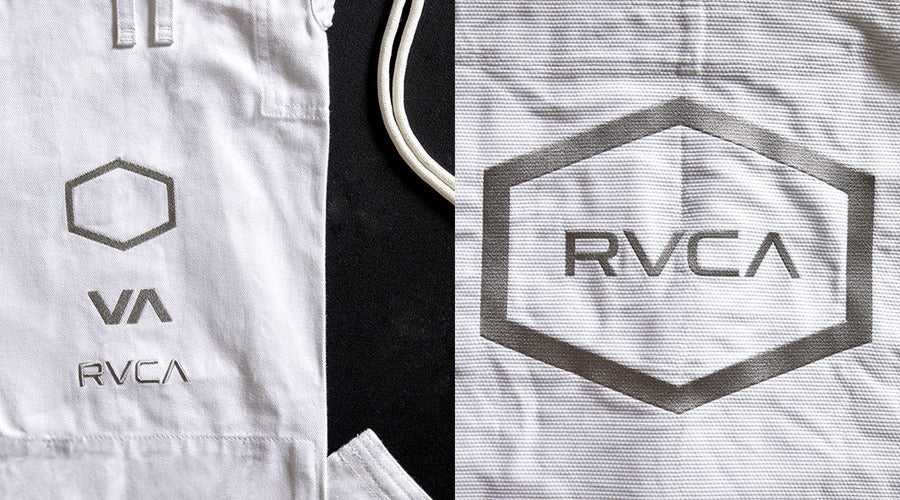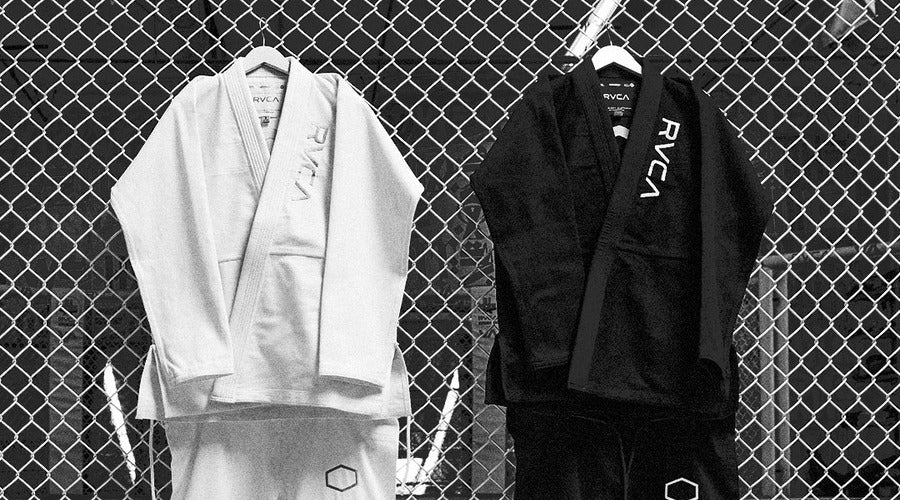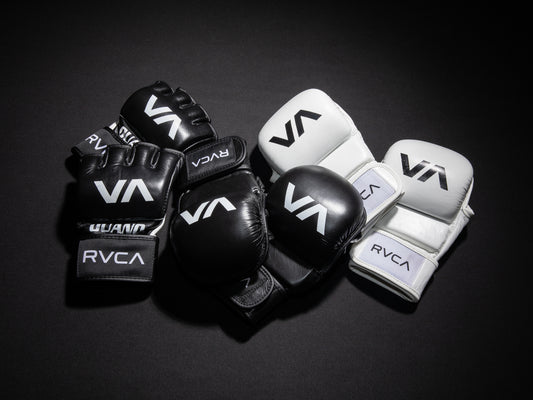The jiu jitsu kimono, more commonly known as a gi, represents the dedication and discipline associated with the sport of BJJ. In this guide, we’ll cover the factors to consider when choosing the right gi size and requirements for your type of training.
What Does Gi Stand For in Jiu Jitsu?

The word "gi" means "clothes" in Japanese. In Brazilian jiu jitsu, a gi is the robe-style top and drawstring pants that make up the discipline’s formal uniform.
A jiu jitsu gi differs from gis (or kimonos) in other disciplines. To withstand the grappling and physical contact in jiu jitsu, the BJJ gi is thicker and more durable than the robe worn in karate, but is more fitted, lightweight and flexible than the gis used for Judo competitions.
Selecting the Proper Size and Fit
Jiu jitsu success is heavily based on flexibility and your ability to grapple or escape from holds, and an improperly fitted gi could restrict your movement and ability to compete.
How Should a Gi Fit?
Many jiu jitsu organizations have specific rules concerning the fit of your gi, and you’ll want to keep them in mind as you shop. Here are a few tips to help you find a good fit once you know your organization's rules.
- The length of your top should reach the thighs, and the sleeves should reach the wrists. Larger and longer sizing can restrict movement and look unkempt.
- Use the four-finger trick to check the length of your sleeves – extend your arm out straight and lay four fingers across the back of your wrist. If your sleeve doesn’t reach your fingers, you won't be competition compliant.
- Your pants should reach your ankles. Using the four-finger test also works to check the length of your pants (while standing, your hem should be within 4 fingers of your ankle).
Kimono Sizing Explained
BJJ gi sizing is noted using an A0 through A6 system. The letter in this system indicates who the gi is for. A (for adult) is for men or general adult sizing. Gis for children feature a Y (for youth), and gis for women feature a W. All sizes correspond to the heights and weights of athletes.
Gi Sizing Chart Jiu Jitsu
|
SIZE |
HEIGHT (FT) |
WEIGHT (LBS) |
|
0 |
5’0” – 5’4” |
110 – 140 |
|
1 |
5’4” – 5’8” |
140 – 165 |
|
2 |
5’8” – 6’0” |
165 – 195 |
|
3 |
5’11” – 6’3” |
195 – 230 |
|
4 |
6’2” – 6’5” |
225 – 250 |
|
5 |
6’5” – 6’8” |
250 – 300 |
Gis are also available in “in-between” and specialty sizes, including wide (W), long (L), and fitted (F). If you fall between sizes, check the garment dimensions to help you determine sleeve and pant lengths that reach your wrists and ankles.
WIDE GI SIZE CHART
|
0W |
5’3” – 5’7” |
165 – 185 |
|
2W |
5’8” – 6’0” |
195 – 225 |
|
3W |
5’6” – 6’0” |
220 – 280 |
LONG GI SIZE CHART
|
1L |
5’6” – 5’11” |
135 – 165 |
|
2L |
5’11” – 6’3” |
165 – 190 |
|
3L |
6’3” – 6’6” |
170 – 205 |
FITTED GI SIZE CHART
|
00F |
4’8” – 5’0” |
85 – 100 |
|
0F |
5’0” – 5’4” |
100 – 125 |
|
1F |
5’4” – 5’7” |
120 – 140 |
How To Choose a Jiu Jitsu Women’s Gi
Women’s gis are sized in W0-W6. Double check with your manufacturer if "W" stands for "women" or "wide", as it may differ across brands. Women’s sizing will also feature tall, slim, and wide fits to ensure a fit that works with your performance.
| Size | Height | Weight |
|---|---|---|
| W0 | 4’10” – 4’11” (145 – 150 cm) | 75 – 95 lbs (35 – 43 kgs) |
| W1 | 4’11” – 5’1” (150 – 155 cm) | 95 – 120 lbs (43 – 55 kgs) |
| W2 | 5’1” – 5’4” (155 – 163 cm) | 120 – 135 lbs (55 – 60 kgs) |
| W3 | 5’4” – 5’8” (163 – 173 cm) | 135 – 148 lbs (60 – 67 kgs) |
| W4 | 5’8” – 5’11” (173 – 180 cm) | 148 – 160 lbs (67 – 73 kgs) |
| W5 | 5’11” – 6’1” (180 – 185 cm) | 160 – 172 lbs (73 – 78 kgs) |
| W6 | 6’1” (185 cm) + | 172 lbs (78 kg) +/td> |
Consider Your Goals, Training Style, and Level
BJJ Gi Requirements for Training
During training, the fit requirements for your gi are more relaxed in fit and length when compared to competition gis. A training gi tends to be thicker in construction so that it can endure many training sessions.
BJJ Gi Requirements for Competition
- Color: In international competitions, BJJ gis must be white, black, or blue, however, local competitions might have more lenient rules. Confirm the color requirements for your organization or competition before choosing your gi.
- Fit: The jacket should be long enough to reach the thighs, and the sleeves must be long enough to reach the wrists.
- Material: A gi must be constructed of cotton or similar material. Excessively thick or stiff gis are not allowed. The gi should also be in good condition – athletes aren't allowed to compete with a ripped or torn gi.
- Belt: The belt for your gi should be 4-5 cm in width.
- Patches: Organizations decide where and whether athletes are allowed to have patches on their gi. Before placing patches on your gi, check your organization’s rule book.
Jiu Jitsu Styles
There are a variety of jiu jitsu styles and approaches. Combat and pressure-based styles will call for a thicker, more durable gi to prevent rips or tears that could disqualify you from a competition. Passing, self-defense, and striking-based jiu jitsu practices require a more lightweight gi for quick and free-flowing movement.
Color Options Outside of Competition
Like in competitions, white, black, or blue gis are common colors for training. For beginners, a solid white or black gi will ensure you have a suitable gi color no matter where you workout.
Fabrics, Weave, and Weight
Common Gi Fabrics
Gis are either 100% cotton or constructed from cotton blended with nylon or polyester. Some gis also come pre-shrunk. Always check the care instructions on your gi to keep it in the best condition possible.
- Cotton: A 100% cotton gi will typically be lightweight. These are ideal for beginners or during training. A fully cotton gi allows for free movement but might be prone to tearing in rough grappling scenarios.
- Cotton blend: Cotton blends tend to have a bit more durability, but their stiffness and rougher feel could be restrictive to a beginner.

Common Gi Weaves
- Single weave: Weaving through one thread and under another, giving a smoother and more streamlined appearance. The most common of gi weaves, single weave tends to be the go-to for beginner and training gis. The single weave is a dependable and timeless standard.
- Double weave: Made by weaving through two sets of horizontal threads, double weave gis are often stiffer and heavier. They have higher GSM and can hold up through many sessions but won’t offer as much freedom of movement as other weaves.
- Pearl weave: Vertically alternating looser and wider weaves with tighter and thinner weaves, giving the appearance of a string of pearls. The pearl weave is the most premium type of gi weave. It’s lightweight, breathable, and durably constructed.
- Gold weave: Horizontally alternating looser and wider weaves with tighter and thinner weaves, giving the appearance of a ladder. Gold weave provides a lightweight yet durable construction that balances the need for mobility and long-lasting garments. However, it’s sometimes known to shrink.
Common Gi Weights
- Lightweight: Lightweight gis are known for their breathability and free motion, but because of their lighter construction, they wear more quickly and can tear in rough grappling and combat situations.
- Heavyweight: Heavyweight gis are ideal for long-lasting and durable protection during competition and training. The heavy construction lasts longer but isn’t as breathable or favorable to free movement.
In addition to choosing a quality gi, your care routine can help extend your gi’s lifespan. Check out our dedicated article on "How To Wash and Care for Your JJ Gi" to keep your gi in top condition for longer.

Additional BJJ Gi Features
Collar Types and Thicknesses
Gi collars are usually filled with cotton or rubber. While cotton collars tend to accompany lighter-weight gis, these are easy for your opponent to grab. Rubber collars are more durable but can sometimes feel rough or uncomfortable. Your jiu jitsu organization might have specific rules regarding collar width, so check the regulations first.
Pant Styles and Cuffs
Jiu jitsu gis come in fitted or loose pant styles. Choose pants that allow for comfortable movement and reach your ankles to ensure fit compliance.
While gis are an essential element to your jiu jitsu practice, they come with a variety of features and in many fits and styles. Start by researching the rules of your gym or competition then use personal preference and training level to decide which one is right for you.


















